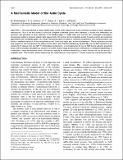A Mechanistic Model of the Actin Cycle
Author(s)
Bindschadler, M.; Osborn, E. A.; Dewey, C. F. Jr; McGrath, J. L.
DownloadDewey-2004-A Mechanistic.pdf (355.9Kb)
Metadata
Show full item recordAbstract
We have derived a broad, deterministic model of the steady-state actin cycle that includes its major regulatory
mechanisms. Ours is the first model to solve the complete nucleotide profile within filaments, a feature that determines the
dynamics and geometry of actin networks at the leading edges of motile cells, and one that has challenged investigators
developing models to interpret steady-state experiments. We arrived at the nucleotide profile through analytic and numerical
approaches that completely agree. Our model reproduces behaviors seen in numerous experiments with purified proteins, but
allows a detailed inspection of the concentrations and fluxes that might exist in these experiments. These inspections provide
new insight into the mechanisms that determine the rate of actin filament treadmilling. Specifically, we find that mechanisms for
enhancing Pi release from the ADP-Pi intermediate on filaments, for increasing the off rate of ADP-bound subunits at pointed
ends, and the multiple, simultaneous functions of profilin, make unique and essential contributions to increased treadmilling. In
combination, these mechanisms have a theoretical capacity to increase treadmilling to levels limited only by the amount of
available actin. This limitation arises because as the cycle becomes more dynamic, it tends toward the unpolymerized state.
Description
Biophysical Journal, 2004
Date issued
2004-05Department
Massachusetts Institute of Technology. Department of Mechanical EngineeringPublisher
Biophysical Society
Citation
Biophysical Journal, 86, p. 2720-2739, (2004)
Keywords
Actin Cycle, nucleotide profile, actin filament